Comparison between Platelet Lysate, Platelet Lysate Serum, and Fetal Bovine Serum as Supplements for Cell Culture, Expansion, and Cryopreservation
Abstract
1. Introduction
2. Materials and Methods
2.1. Obtaining Platelet Units
2.2. Preparation of Platelet Pools
2.3. Obtaining Platelet Lysate and Platelet Lysate Serum
2.4. FBS Storage
2.5. Biochemical Analysis of PL, PLS, and FBS
2.6. Growth Factor and Cytokine Analysis
2.7. Isolation and Culture of Dermal Fibroblasts
2.8. Isolation and Culture of Wharton’s Jelly Mesenchymal Stem Cells (WJ-MSCs)
2.9. Isolation and Culture of Adipose Tissue Mesenchymal Stem Cells (AdMSC)
2.10. Evaluation of PL, PLS, and FBS as a Supplement to the Culture Medium
2.11. Evaluation of PL, PLS, and FBS as Media for Cryopreservation
2.12. Statistical Analysis
3. Results
3.1. Biochemical Composition of PL, PLS, and FBS
3.2. Growth Factor and Cytokine Analysis
3.3. Proliferation Kinetics of Fibroblasts, WJ MSCs and AdMSCs
3.4. Efficiency of PL, PLS, and FBS in Cell Cryopreservation
4. Discussion
5. Conclusions
Author Contributions
Funding
Institutional Review Board Statement
Informed Consent Statement
Data Availability Statement
Acknowledgments
Conflicts of Interest
References
- Hemeda, H.; Giebel, B.; Wagner, W. Evaluation of human platelet lysate versus fetal bovine serum for culture of mesenchymal stromal cells. Cytotherapy 2014, 16, 170–180. [Google Scholar] [CrossRef]
- Cañas-Arboleda, M.; Beltrán, K.; Medina, C.; Camacho, B.; Salguero, G. Human Platelet Lysate Supports Efficient Expansion and Stability of Wharton’s Jelly Mesenchymal Stromal Cells via Active Uptake and Release of Soluble Regenerative Factors. Int. J. Mol. Sci. 2020, 21, 6284. [Google Scholar] [CrossRef] [PubMed]
- Laner-Plamberger, S.; Oeller, M.; Mrazek, C.; Hartl, A.; Sonderegger, A.; Rohde, E.; Strunk, D.; Schallmoser, K. Upregulation of mitotic bookmarking factors during enhanced proliferation of human stromal cells in human platelet lysate. J. Transl. Med. 2019, 17, 432. [Google Scholar] [CrossRef] [PubMed]
- Lee, D.Y.; Lee, S.Y.; Yun, S.H.; Jeong, J.W.; Kim, J.H.; Kim, H.W.; Choi, J.S.; Kim, G.-D.; Joo, S.T.; Choi, I.; et al. Review of the Current Research on Fetal Bovine Serum and the Development of Cultured Meat. Food Sci. Anim. Resour. 2022, 42, 775–799. [Google Scholar] [CrossRef]
- Naji, A.; Eitoku, M.; Favier, B.; Deschaseaux, F.; Rouas-Freiss, N.; Suganuma, N. Biological functions of mesenchymal stem cells and clinical implications. Cell. Mol. Life Sci. 2019, 76, 3323–3348. [Google Scholar] [CrossRef]
- El-Sayed, M.; El-Feky, M.A.; El-Amir, M.I.; Hasan, A.S.; Tag-Adeen, M.; Urata, Y.; Goto, S.; Luo, L.; Yan, C.; Li, T.-S. Immunomodulatory effect of mesenchymal stem cells: Cell origin and cell quality variations. Mol. Biol. Rep. 2019, 46, 1157–1165. [Google Scholar] [CrossRef] [PubMed]
- Galipeau, J.; Sensébé, L. Mesenchymal Stromal Cells: Clinical Challenges and Therapeutic Opportunities. Cell Stem Cell 2018, 22, 824–833. [Google Scholar] [CrossRef]
- Kølle, S.F.T.; Oliveri, R.S.; Glovinski, P.V.; Kirchhoff, M.; Mathiasen, A.B.; Elberg, J.J.; Andersen, P.S.; Drzewiecki, K.T.; Fischer-Nielsen, A. Pooled human platelet lysate versus fetal bovine serum—Investigating the proliferation rate, chromosome stability and angiogenic potential of human adipose tissue-derived stem cells intended for clinical use. Cytotherapy 2013, 15, 1086–1097. [Google Scholar] [CrossRef]
- Lynch, M.D.; Watt, F.M. Fibroblast heterogeneity: Implications for human disease. J. Clin. Investig. 2018, 128, 26–35. [Google Scholar] [CrossRef]
- Talbott, H.E.; Mascharak, S.; Griffin, M.; Wan, D.C.; Longaker, M.T. Wound healing, fibroblast heterogeneity, and fibrosis. Cell Stem Cell 2022, 29, 1161–1180. [Google Scholar] [CrossRef]
- van der Valk, J.; Mellor, D.; Brands, R.; Fischer, R.; Gruber, F.; Gstraunthaler, G.; Hellebrekers, L.; Hyllner, J.; Jonker, F.H.; Prieto, P.; et al. The humane collection of fetal bovine serum and possibilities for serum-free cell and tissue culture. Toxicol. In Vitro 2004, 18, 1–12. [Google Scholar] [CrossRef] [PubMed]
- Honn, K.V.; Singley, J.A.; Chavin, W. Fetal Bovine Serum: A Multivariate Standard. Proc. Soc. Exp. Biol. Med. 1975, 149, 344–347. [Google Scholar] [CrossRef] [PubMed]
- Gstraunthaler, G. Alternatives to the use of fetal bovine serum: Serum-free cell culture. ALTEX 2003, 20, 275–281. [Google Scholar] [CrossRef] [PubMed]
- Chelladurai, K.S.; Christyraj, J.D.S.; Rajagopalan, K.; Yesudhason, B.V.; Venkatachalam, S.; Mohan, M.; Vasantha, N.C.; Christyraj, J.R.S.S. Alternative to FBS in animal cell culture—An overview and future perspective. Heliyon 2021, 7, e07686. [Google Scholar] [CrossRef]
- van der Valk, J.K.; Bieback, K.; Buta, C.; Cochrane, B.; Dirks, W.G.; Fu, J.; Hickman, J.; Hohensee, C.; Kolar, R.; Liebsch, M.; et al. Fetal bovine serum (FBS): Past–present–future. ALTEX Altern. Anim. Exp. 2018, 35, 99–118. [Google Scholar] [CrossRef]
- Mohamed, H.E.; Asker, M.E.; Kotb, N.S.; Habab, A.M.E. Human platelet lysate efficiency, stability, and optimal heparin concentration required in culture of mammalian cells. Blood Res. 2020, 55, 35–43. [Google Scholar] [CrossRef]
- Burnouf, T.; Strunk, D.; Koh, M.B.C.; Schallmoser, K. Human platelet lysate: Replacing fetal bovine serum as a gold standard for human cell propagation? Biomaterials 2016, 76, 371–387. [Google Scholar] [CrossRef]
- van der Valk, J.; Brunner, D.; De Smet, K.; Fex Svenningsen, A.; Honegger, P.; Knudsen, L.E.; Lindl, T.; Noraberg, J.; Price, A.; Scarino, M.L.; et al. Optimization of chemically defined cell culture media—Replacing fetal bovine serum in mammalian in vitro methods. Toxicol. In Vitro 2010, 24, 1053–1063. [Google Scholar] [CrossRef]
- Sundman, E.A.; Cole, B.J.; Fortier, L.A. Growth Factor and Catabolic Cytokine Concentrations Are Influenced by the Cellular Composition of Platelet-Rich Plasma. Am. J. Sports Med. 2011, 39, 2135–2140. [Google Scholar] [CrossRef]
- Mussano, F.; Genova, T.; Munaron, L.; Petrillo, S.; Erovigni, F.; Carossa, S. Cytokine, chemokine, and growth factor profile of platelet-rich plasma. Platelets 2016, 27, 467–471. [Google Scholar] [CrossRef]
- Durante, C.; Agostini, F.; Abbruzzese, L.; Toffola, R.T.; Zanolin, S.; Suine, C.; Mazzucato, M. Growth factor release from platelet concentrates: Analytic quantification and characterization for clinical applications. Vox Sang. 2013, 105, 129–136. [Google Scholar] [CrossRef] [PubMed]
- Oeller, M.; Laner-Plamberger, S.; Krisch, L.; Rohde, E.; Strunk, D.; Schallmoser, K. Human Platelet Lysate for Good Manufacturing Practice-Compliant Cell Production. Int. J. Mol. Sci. 2021, 22, 5178. [Google Scholar] [CrossRef] [PubMed]
- Hesler, M.; Kohl, Y.; Wagner, S.; von Briesen, H. Non-pooled Human Platelet Lysate: A Potential Serum Alternative for In Vitro Cell Culture. Altern. Lab. Anim. 2019, 47, 116–127. [Google Scholar] [CrossRef] [PubMed]
- Schallmoser, K.; Strunk, D. Generation of a Pool of Human Platelet Lysate and Efficient Use in Cell Culture. In Basic Cell Culture Protocols; Helgason, C.D., Miller, C.L., Eds.; Methods in Molecular Biology; Humana Press; Springer Protocols: Totowa, NJ, USA, 2013; pp. 349–362. [Google Scholar] [CrossRef]
- Schallmoser, K.; Strunk, D. Preparation of Pooled Human Platelet Lysate (pHPL) as an Efficient Supplement for Animal Serum-Free Human Stem Cell Cultures. J. Vis. Exp. 2009, 32, e1523. [Google Scholar] [CrossRef]
- Amable, P.R.; Carias, R.B.V.; Teixeira, M.V.T.; da Cruz Pacheco, Í.; Corrêa do Amaral, R.J.F.; Granjeiro, J.M.; Borojevic, R. Platelet-rich plasma preparation for regenerative medicine: Optimization and quantification of cytokines and growth factors. Stem Cell Res. Ther. 2013, 4, 67. [Google Scholar] [CrossRef] [PubMed]
- Dominici, M.; Blanc, K.L.; Mueller, I.; Slaper-Cortenbach, I.; Marini, F.C.; Krause, D.S.; Deans, R.J.; Keating, A.; Prockop, D.J.; Horwitz, E.M. Minimal criteria for defining multipotent mesenchymal stromal cells. The International Society for Cellular Therapy position statement. Cytotherapy 2006, 8, 315–317. [Google Scholar] [CrossRef] [PubMed]
- Horn, P.; Bokermann, G.; Cholewa, D.; Bork, S.; Walenda, T.; Koch, C.; Drescher, W.; Hutschenreuther, G.; Zenke, M.; Ho, A.D.; et al. Impact of individual platelet lysates on isolation and growth of human mesenchymal stromal cells. Cytotherapy 2010, 12, 888–898. [Google Scholar] [CrossRef]
- Laner-Plamberger, S.; Lener, T.; Schmid, D.; Streif, D.A.; Salzer, T.; Öller, M.; Hauser-Kronberger, C.; Fischer, T.; Jacobs, V.R.; Schallmoser, K.; et al. Mechanical fibrinogen-depletion supports heparin-free mesenchymal stem cell propagation in human platelet lysate. J. Transl. Med. 2015, 13, 354. [Google Scholar] [CrossRef]
- Fernández Muñoz, B.; Lopez-Navas, L.; Gonzalez Bermejo, M.; Lomas Romero, I.M.; Montiel Aguilera, M.Á.; Campos Cuerva, R.; Arribas Arribas, B.; Nogueras, S.; Carmona Sánchez, G.; Santos González, M. A proprietary GMP human platelet lysate for the expansion of dermal fibroblasts for clinical applications. Platelets 2022, 33, 98–109. [Google Scholar] [CrossRef]
- Bernardi, M.; Agostini, F.; Chieregato, K.; Amati, E.; Durante, C.; Rassu, M.; Ruggeri, M.; Sella, S.; Lombardi, E.; Mazzucato, M.; et al. The production method affects the efficacy of platelet derivatives to expand mesenchymal stromal cells in vitro. J. Transl. Med. 2017, 15, 90. [Google Scholar] [CrossRef]
- Astori, G.; Amati, E.; Bambi, F.; Bernardi, M.; Chieregato, K.; Schäfer, R.; Sella, S.; Rodeghiero, F. Platelet lysate as a substitute for animal serum for the ex-vivo expansion of mesenchymal stem/stromal cells: Present and future. Stem Cell Res. Ther. 2016, 7, 93. [Google Scholar] [CrossRef] [PubMed]
- Shih, D.T.B.; Burnouf, T. Preparation, quality criteria, and properties of human blood platelet lysate supplements for ex vivo stem cell expansion. New Biotechnol. 2015, 32, 199–211. [Google Scholar] [CrossRef] [PubMed]
- Guiotto, M.; Raffoul, W.; Hart, A.M.; Riehle, M.O.; di Summa, P.G. Human platelet lysate to substitute fetal bovine serum in hMSC expansion for translational applications: A systematic review. J. Transl. Med. 2020, 18, 351. [Google Scholar] [CrossRef] [PubMed]
- Pierce, J.; Benedetti, E.; Preslar, A.; Jacobson, P.; Jin, P.; Stroncek, D.F.; Reems, J.A. Comparative analyses of industrial-scale human platelet lysate preparations. Transfusion 2017, 57, 2858–2869. [Google Scholar] [CrossRef]
- Shanskii, Y.D.; Sergeeva, N.S.; Sviridova, I.K.; Kirakozov, M.S.; Kirsanova, V.A.; Akhmedova, S.A.; Antokhin, A.I.; Chissov, V.I. Human Platelet Lysate as a Promising Growth-Stimulating Additive for Culturing of Stem Cells and other Cell Types. Bull. Exp. Biol. Med. 2013, 156, 146–151. [Google Scholar] [CrossRef]
- Becherucci, V.; Piccini, L.; Casamassima, S.; Bisin, S.; Gori, V.; Gentile, F.; Ceccantini, R.; De Rienzo, E.; Bindi, B.; Pavan, P.; et al. Human platelet lysate in mesenchymal stromal cell expansion according to a GMP grade protocol: A cell factory experience. Stem Cell Res. Ther. 2018, 9, 124. [Google Scholar] [CrossRef]
- Bieback, K.; Fernandez-Muñoz, B.; Pati, S.; Schäfer, R. Gaps in the knowledge of human platelet lysate as a cell culture supplement for cell therapy: A joint publication from the AABB and the International Society for Cell & Gene Therapy. Transfusion 2019, 59, 3448–3460. [Google Scholar] [CrossRef]
- Hemeda, H.; Kalz, J.; Walenda, G.; Lohmann, M.; Wagner, W. Heparin concentration is critical for cell culture with human platelet lysate. Cytotherapy 2013, 15, 1174–1181. [Google Scholar] [CrossRef]
- Linkova, D.D.; Rubtsova, Y.P.; Egorikhina, M.N. Cryostorage of Mesenchymal Stem Cells and Biomedical Cell-Based Products. Cells 2022, 11, 2691. [Google Scholar] [CrossRef]
- Isildar, B.; Ozkan, S.; Oncul, M.; Baslar, Z.; Kaleli, S.; Tasyurekli, M.; Koyuturk, M. Comparison of different cryopreservation protocols for human umbilical cord tissue as source of mesenchymal stem cells. Acta Histochem. 2019, 121, 361–367. [Google Scholar] [CrossRef]
- Martín-López, M.; Rosell-Valle, C.; Arribas-Arribas, B.; Fernández-Muñoz, B.; Jiménez, R.; Nogueras, S.; García-Delgado, A.B.; Campos, F.; Santos-González, M. Bioengineered tissue and cell therapy products are efficiently cryopreserved with pathogen-inactivated human platelet lysate-based solutions. Stem Cell Res. Ther. 2023, 14, 69. [Google Scholar] [CrossRef] [PubMed]
- Escobar, C.H.; Chaparro, O. Xeno-Free Extraction, Culture, and Cryopreservation of Human Adipose-Derived Mesenchymal Stem Cells. Stem Cells Transl. Med. 2016, 5, 358–365. [Google Scholar] [CrossRef] [PubMed]
- Wang, C.; Xiao, R.; Cao, Y.L.; Yin, H.Y. Evaluation of human platelet lysate and dimethyl sulfoxide as cryoprotectants for the cryopreservation of human adipose-derived stem cells. Biochem. Biophys. Res. Commun. 2017, 491, 198–203. [Google Scholar] [CrossRef] [PubMed]
- Taylor, C.G.; Dayment, R.N.; Albanna, M.Z.; Woods, E.J. Freezing and recovery of mesenchymal stem cells in human platelet lysate. Cytotherapy 2014, 16, S100. [Google Scholar] [CrossRef]
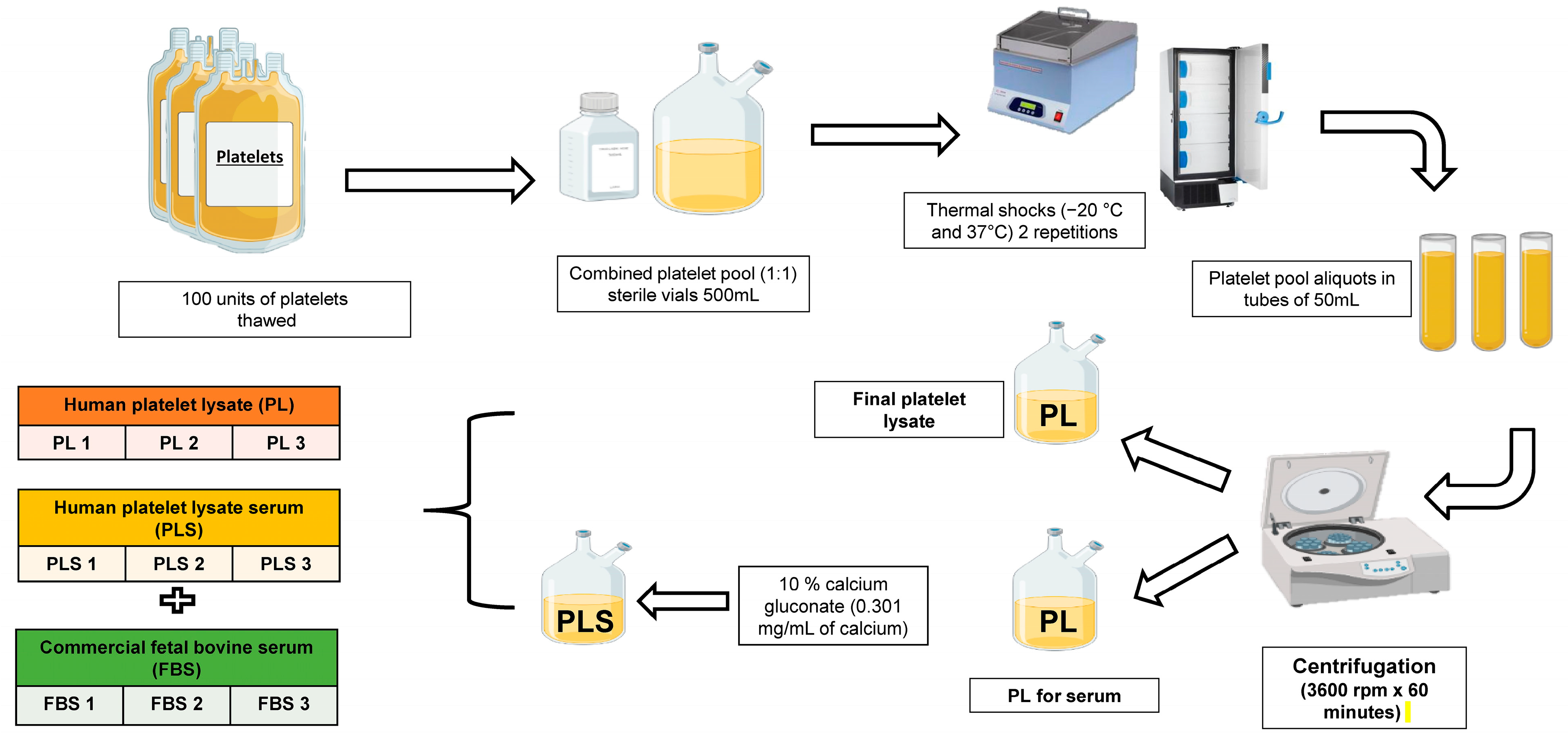
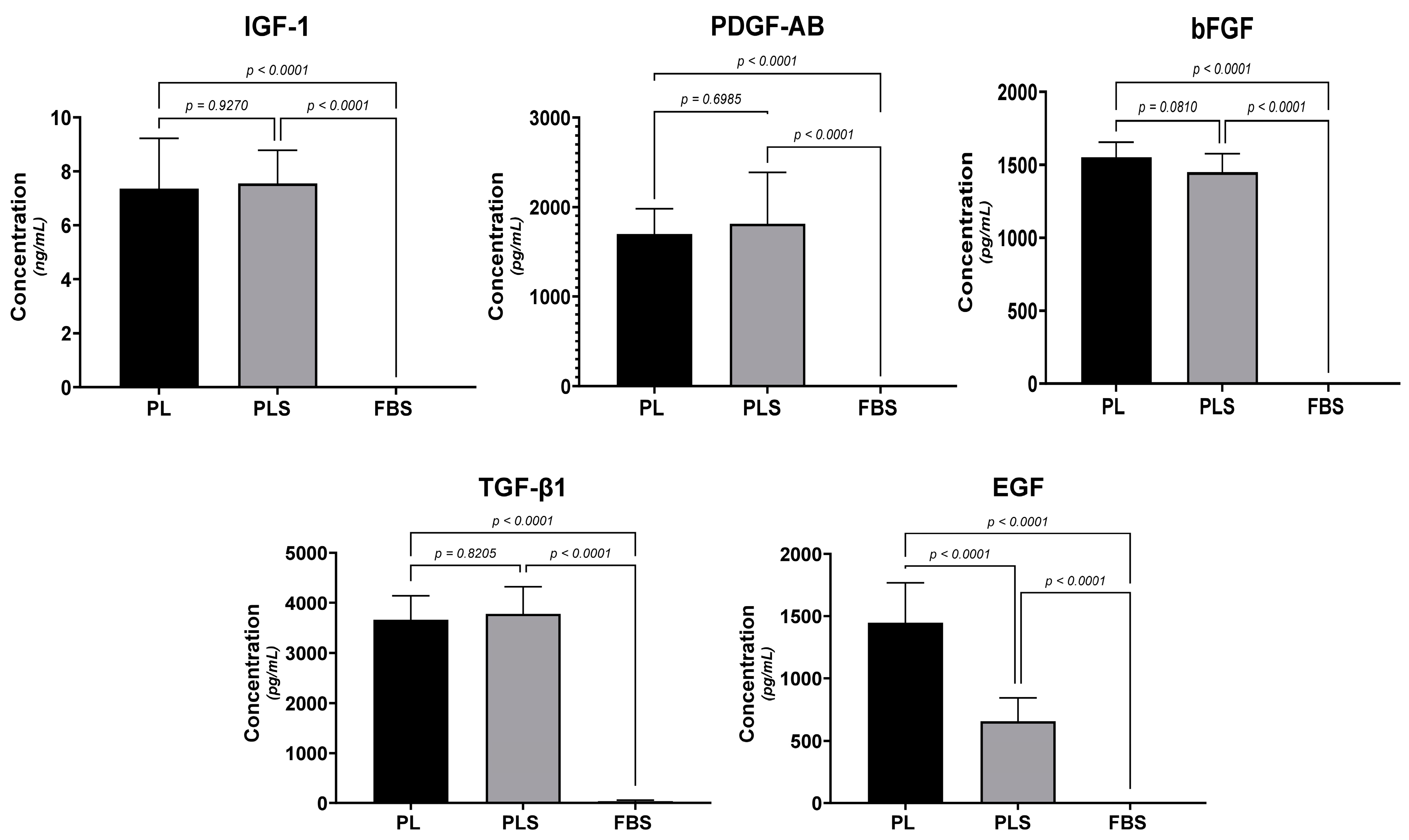
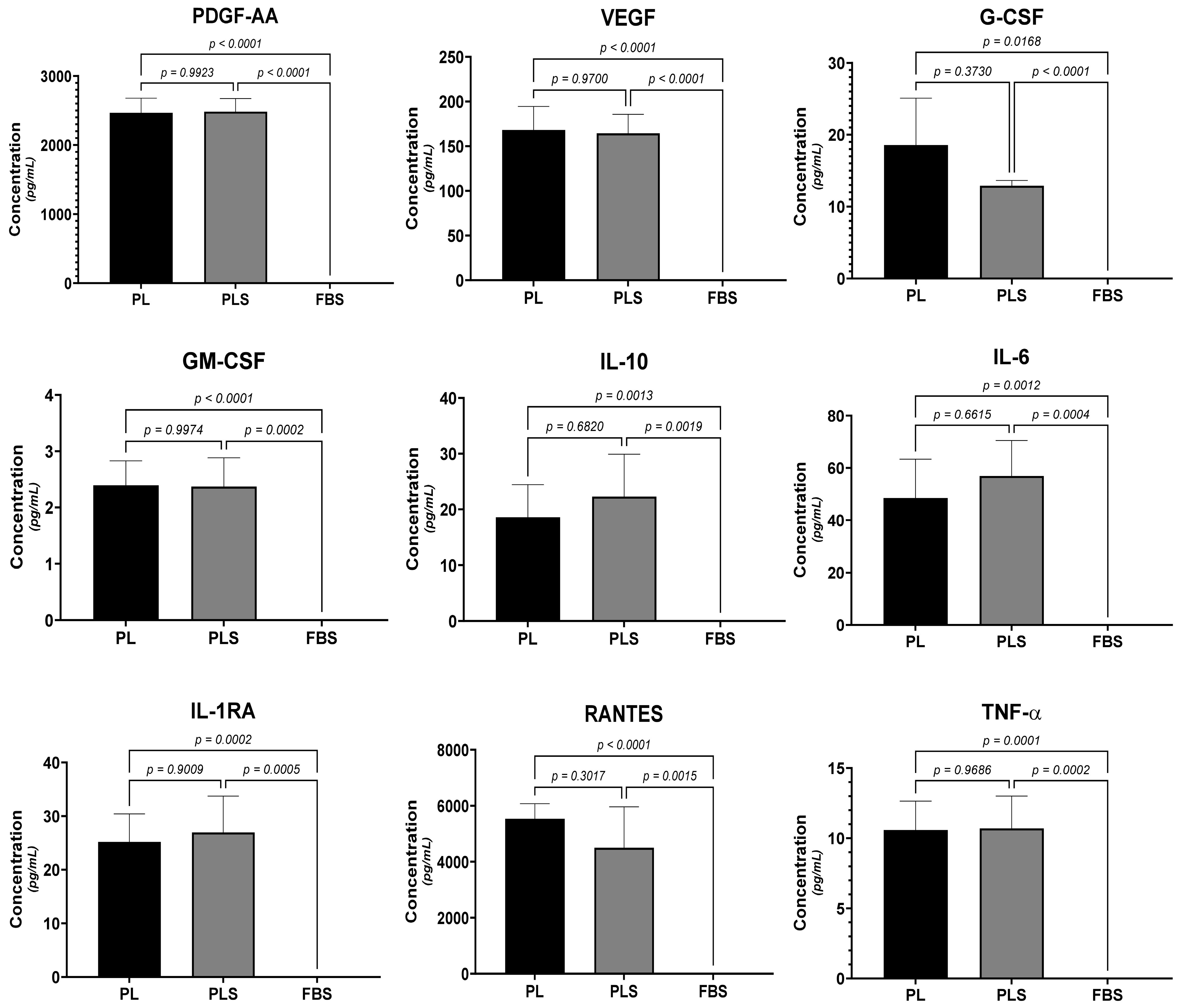

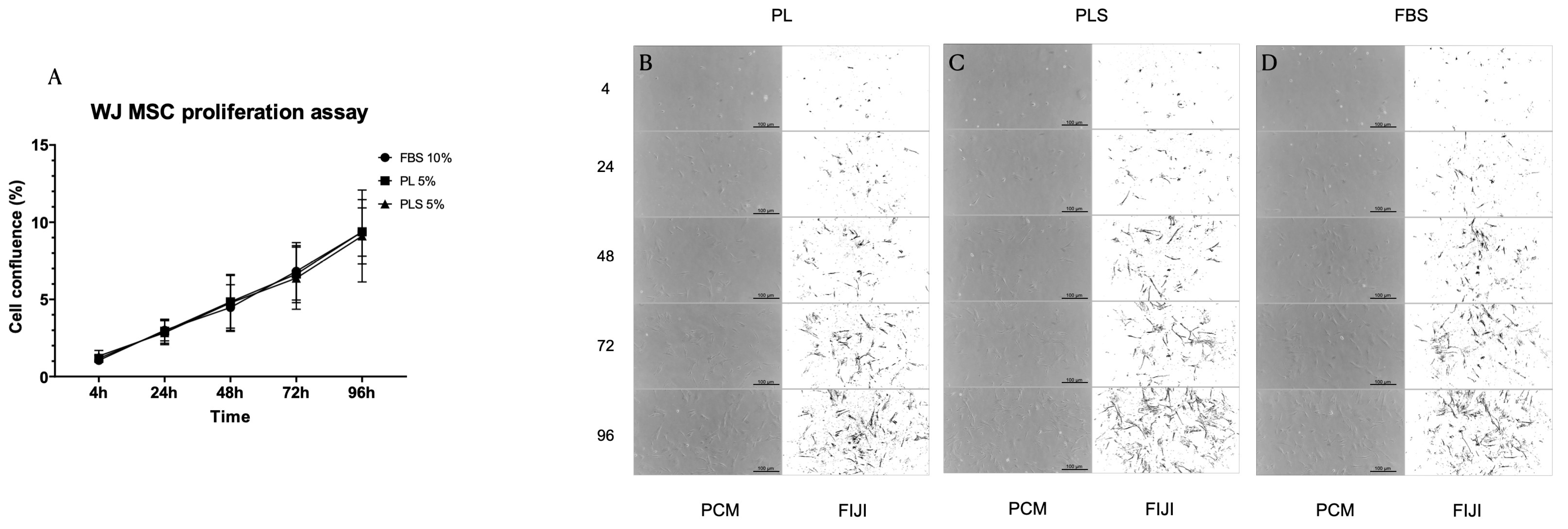

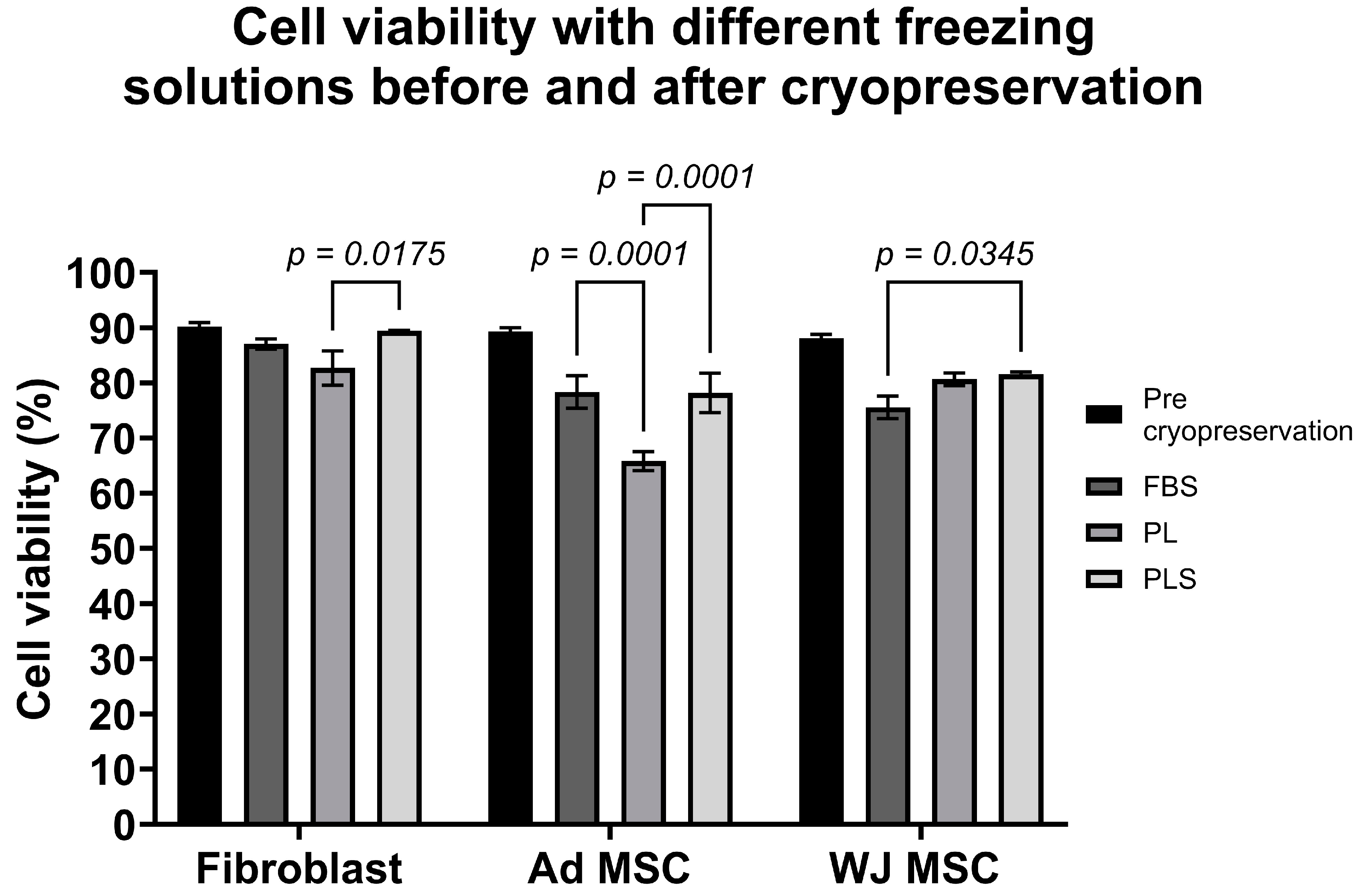
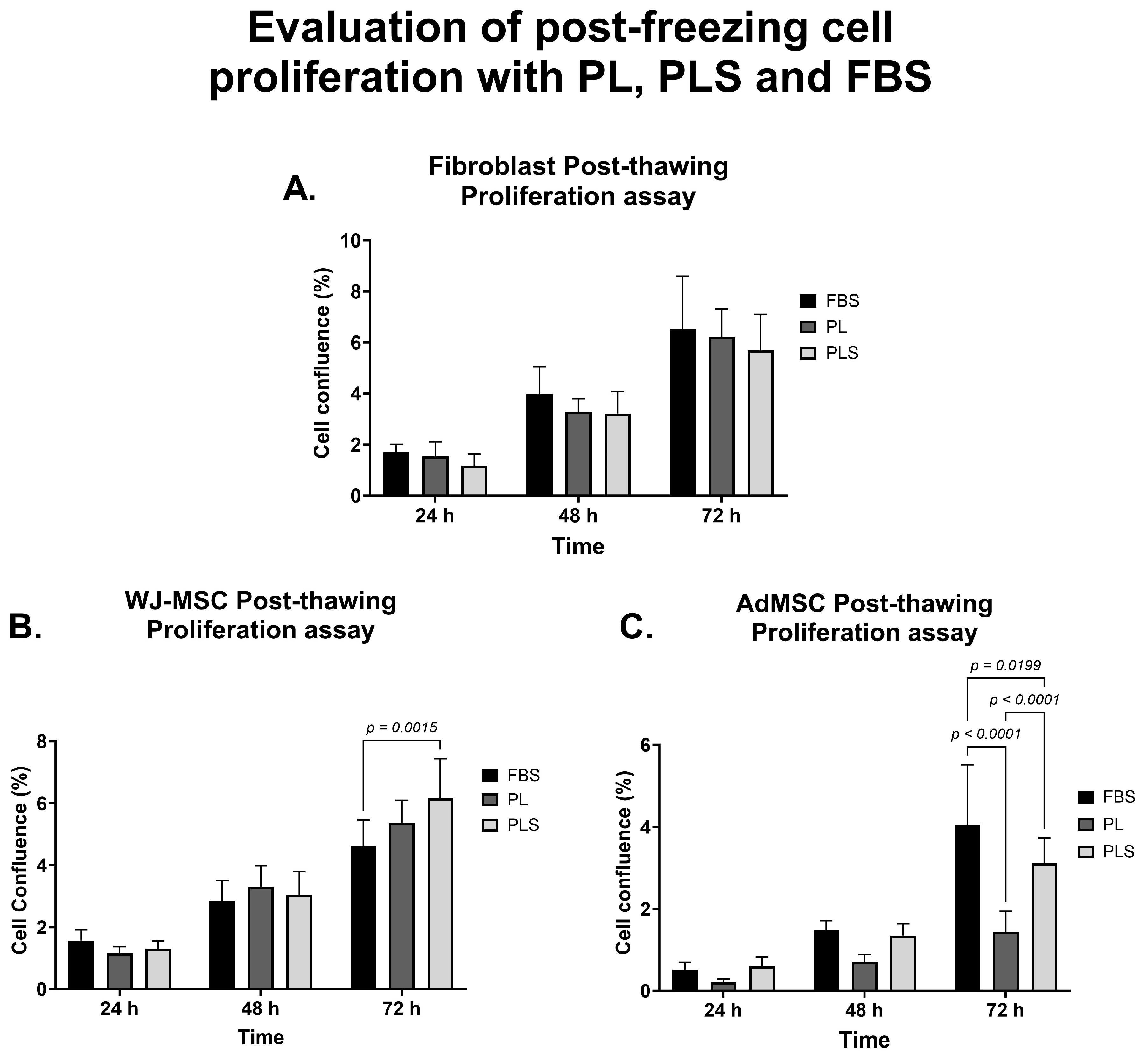
| Cryopreservation Solution | DMSO 10% + PL 90% | DMSO 10% + PLS 90% | DMSO 10% + FBS 90% | |||
|---|---|---|---|---|---|---|
| Replicas | Replicas | Replicas | ||||
| Cellular type | 1 | 2 | 1 | 2 | 1 | 2 |
| Fibroblasts | 6.7 × 105 | 6.7 × 105 | 6.7 × 105 | 6.7 × 105 | 6.7 × 105 | 6.7 × 105 |
| WJ-MSC | 1.0 × 106 | 1.0 × 106 | 1.0 × 106 | 1.0 × 106 | 1.0 × 106 | 1.0 × 106 |
| AdMSC | 1.0 × 106 | 1.0 × 106 | 1.0 × 106 | 1.0 × 106 | 1.0 × 106 | 1.0 × 106 |
| Cryopreservation time | 7 days | 7 days | 7 days | |||
| Thawing solution | 70% DMEM/Ham-F12 + 30% PL | 70% DMEM/Ham-F12 + 30% PLS | 70% DMEM/Ham-F12 + 30% FBS | |||
| Viability | Trypan blue | Trypan blue | Trypan blue | |||
| Adhesion and proliferation | 1.75 × 104 | 1.75 × 104 | 1.75 × 104 | 1.75 × 104 | 1.75 × 104 | 1.75 × 104 |
| Sowing for 72 h | Sowing for 72 h | Sowing for 72 h | ||||
| Supplements | Reference Plasma Values | |||
|---|---|---|---|---|
| PL | PLS | FBS | ||
| Total proteins (gr/dL) | 5.93 ± 0.2 | 5.73 ± 0.2 | 3.58 ± 0.2 | 6–7.8 |
| Albumin (gr/dL) | 3.89 ± 0.0 | 3.78 ± 0.1 | 2.61 ± 0.1 | 3.5–5.4 |
| Transferrin (mg/dL) | 206.28 ± 3.6 *** | 206.28 ± 9.4 *** | 0.1 ± 0.2 | 212–360 |
| Ferritin (ng/mL) | 89.62 ± 5.5 *** | 86.97 ± 8.1 *** | 1.04 ± 0.5 | 30–300 |
| Fibrinogen (mg/dL) | 141 ± 56.5 ***, +++ | <50 | <50 | 150–350 |
| Immunoglobulins (mg/dL) | 1038.16 ± 11.0 ***, + | 1016.82 ± 31.4 ***, + | 4.59 ± 9.1 | 640–1430 |
| Total cholesterol (mg/dL) | 152.14 ± 5.7 *** | 141.81 ± 4.2 *** | 32.58 ± 3.3 | 150–199 |
| LDL (mg/dL) | 103.48 ± 2.5 *** | 96.25 ± 2.5 *** | 20.4 ± 3.8 | <130 |
| HDL (mg/dL) | 35.99 ± 1.2 *** | 34.90 ± 0.9 *** | 5.5 ± 0.3 | >40 |
| Triglycerides (mg/dL) | 121.58 ± 16.1 *** | 103.51 ± 9.1 *** | 49.58 ± 34.8 | <250 |
| Glucose (mg/dL) | 192.75 ± 23.1 *** | 189.75 ± 21.0 *** | 69.25 ± 51.2 | 70–110 |
| Ca2+ (mg/dL) | 7.55 ± 0.0 +++ | 36.04 ± 2.2 *, +++ | 14.44 ± 0.3 | 9–10.5 |
| Cl− (mmol/L) | 83.07 ± 2.4 | 80.55 ± 2.5* | 103.50 ± 1.2 | 98–106 |
| K+ (mmol/L) | 4.26 ± 0.1 | 4.24 ± 0.2 | 10.71 ± 1.4 | 3.5–5 |
| Na+ (mmol/L) | 162.10 ± 4.8 * | 159.13 ± 3.8 * | 137.21 ± 1.4 | 136–145 |
| Mg2+ (mg/dL) | 1.87 ± 0.0 | 2.98 ± 0.1 | 3.32 ± 0.1 | 1.5–2.4 |
| Fe3+ (μg/dL) | 79.5 ± 2.6 *** | 77.5 ± 5.3 *** | 187.75 ± 20.7 | 60–160 |
| Cortisol (μg/dL) | 7.28 ± 0.7 *** | 7.73 ± 1.6 *** | 0.05 ± 0.1 | 3–20 |
| Insulin (mUl/L) | 2.61 ± 0.3 *** | 2.57 ± 1.3 *** | 0.06 ± 0.1 | 2.6–37.6 |
| Triiodothyronine (ng/mL) | 1.21 ± 0.1 | 1.08 ± 0.2 | 3.05 ± 3.3 | 0.7–1.95 |
| Thyroxine (mg/dL) | 7.28 ± 0.3 *** | 7.18 ± 0.3 *** | 15.6 ± 4.6 | 5–12 |
| TSH (uIU/mL) | 1.72 ± 0.2 *** | 1.71 ± 0.3 *** | 0.03 ± 0.0 | 0.5–5 |
Disclaimer/Publisher’s Note: The statements, opinions and data contained in all publications are solely those of the individual author(s) and contributor(s) and not of MDPI and/or the editor(s). MDPI and/or the editor(s) disclaim responsibility for any injury to people or property resulting from any ideas, methods, instructions or products referred to in the content. |
© 2024 by the authors. Licensee MDPI, Basel, Switzerland. This article is an open access article distributed under the terms and conditions of the Creative Commons Attribution (CC BY) license (https://creativecommons.org/licenses/by/4.0/).
Share and Cite
Duarte Rojas, J.M.; Restrepo Múnera, L.M.; Estrada Mira, S. Comparison between Platelet Lysate, Platelet Lysate Serum, and Fetal Bovine Serum as Supplements for Cell Culture, Expansion, and Cryopreservation. Biomedicines 2024, 12, 140. https://doi.org/10.3390/biomedicines12010140
Duarte Rojas JM, Restrepo Múnera LM, Estrada Mira S. Comparison between Platelet Lysate, Platelet Lysate Serum, and Fetal Bovine Serum as Supplements for Cell Culture, Expansion, and Cryopreservation. Biomedicines. 2024; 12(1):140. https://doi.org/10.3390/biomedicines12010140
Chicago/Turabian StyleDuarte Rojas, Juan Manuel, Luz Marina Restrepo Múnera, and Sergio Estrada Mira. 2024. "Comparison between Platelet Lysate, Platelet Lysate Serum, and Fetal Bovine Serum as Supplements for Cell Culture, Expansion, and Cryopreservation" Biomedicines 12, no. 1: 140. https://doi.org/10.3390/biomedicines12010140
APA StyleDuarte Rojas, J. M., Restrepo Múnera, L. M., & Estrada Mira, S. (2024). Comparison between Platelet Lysate, Platelet Lysate Serum, and Fetal Bovine Serum as Supplements for Cell Culture, Expansion, and Cryopreservation. Biomedicines, 12(1), 140. https://doi.org/10.3390/biomedicines12010140





